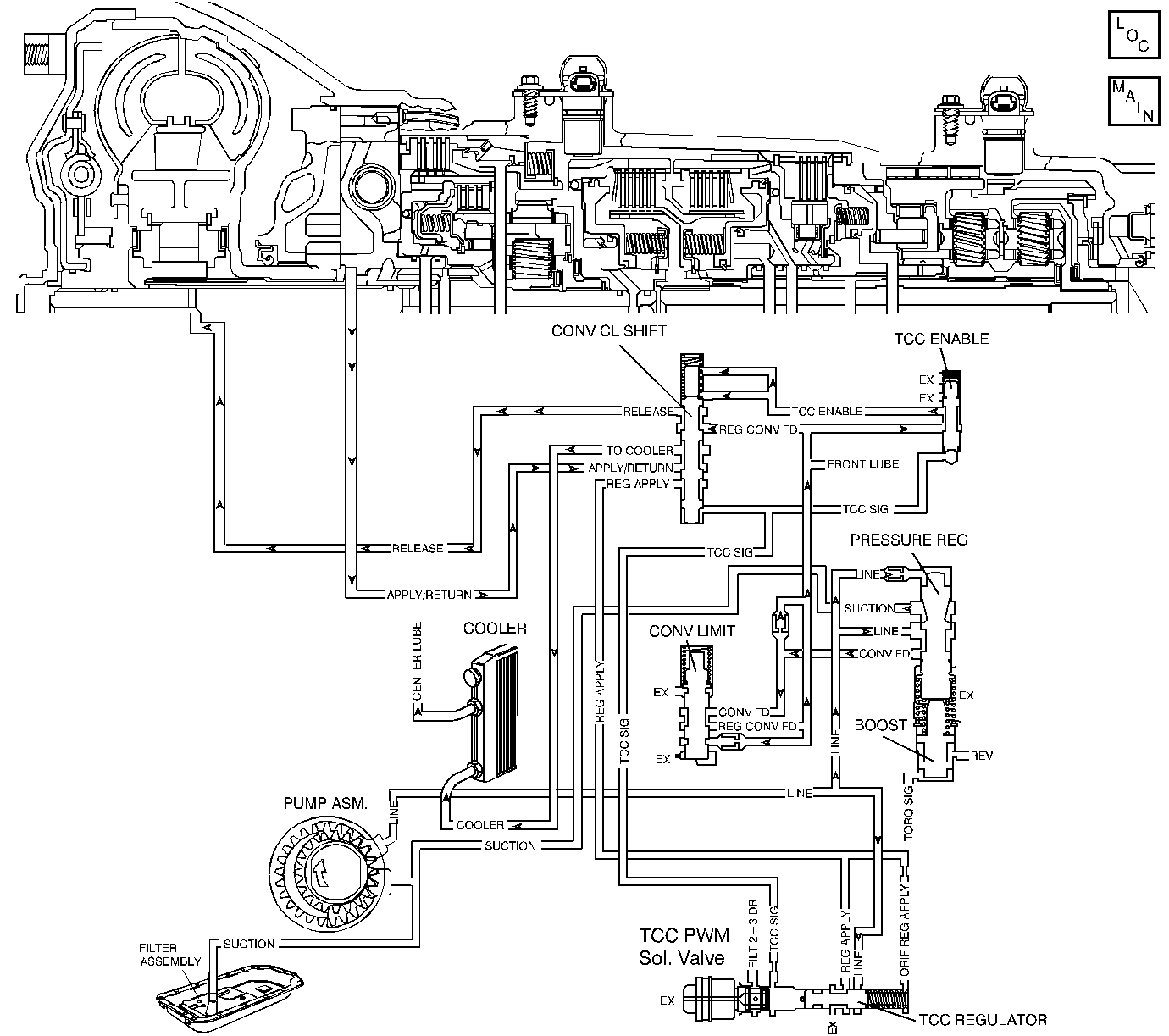DTC 79 Transmission Fluid Overtemperature L57 MFI

Circuit Description
The flow of transmission fluid starts in the transmission pan. It is then drawn through the filter and transmission case into the oil pump assembly. The oil pump assembly pressurizes the fluid (line pressure), which becomes the main supply line of fluid. This fluid is directed to various components and hydraulic circuits within the transmission. The pressure regulator valve receives this fluid and directs it to the converter clutch shift valve. The converter clutch shift valve directs hot fluid leaving the torque converter, or regulated converter feed fluid, through the cooler line to the transmission oil cooler. The transmission oil cooler is located in the radiator. The vehicle may also be equipped with an auxiliary oil cooler. The cooled fluid (center lube) is returned to the transmission through the return cooler line and into center lube port of the transmission. The automatic transmission fluid temperature (TFT) sensor, senses the fluid temperature in the transmission pan.
If the transmission control module (TCM) detects a high TFT for a long period of time, then DTC 79 sets.
Conditions for Running the DTC
| • | The ignition is ON. |
| • | No TFT sensor DTC 58. |
Conditions for Setting the DTC
| • | The TFT is greater than 146°C (295°F). |
| • | All conditions are met for 27 minutes and 30 seconds. |
Action Taken When the DTC Sets
| • | The TCM does not illuminate the malfunction indicator lamp (MIL). |
| • | The TCM freeze shift adapts from being updated. |
| • | Soft landing to default 2nd gear. |
| • | The TCM stores DTC 79 in TCM history. |
Conditions for Clearing the DTC
| • | A scan tool clears the DTC from TCM history. |
| • | The TCM clears the DTC from TCM history if the vehicle completes 40 consecutive key cycles without a diagnostic fault occurring. |
| • | The TCM cancels the DTC default actions when the fault no longer exists and the ignition switch is OFF long enough in order to power down the TCM. |
Diagnostic Aids
| • | Inspect the cooling system fluid level and condition. |
| • | Verify the customer's driving habits, such as trailer towing, etc... |
| • | The scan tool transmission fluid temperature (TFT) should rise steadily during warm-up cycles, then stabilize. |
| • | DTC 79 may set approximately 600 seconds after DTC 58 has set. Follow the diagnostic table for DTC 58 before proceeding to the diagnostic table for DTC 79. Repairing the condition that set DTC 58 will likely eliminate DTC 79. |
Test Description
The numbers below refer to the step numbers on the diagnostic table.
-
DTC 58 may also set a DTC 79. Go to the DTC 58 tables for diagnosis.
-
This step inspects for air restrictions and loss of transmission fluid flow, causing an extremely high TFT.
Step | Action | Value(s) | Yes | No | ||||||||||||||
|---|---|---|---|---|---|---|---|---|---|---|---|---|---|---|---|---|---|---|
1 | Was the Powertrain On-Board Diagnostic (OBD) System Check performed? | -- | ||||||||||||||||
2 |
Important:: Before clearing the DTCs, use the scan tool in order to record the Failure Records. Using the Clear Info function erases the Failure Records from the TCM. Refer to Transmission Fluid Check . Was the Transmission Fluid Checking Procedure performed? | -- | Go to Transmission Fluid Check | |||||||||||||||
Is DTC 58 also set? | -- | Go to Diagnostic Aids | ||||||||||||||||
Refer to Automatic Transmission Oil Cooler Flow Test . Was a condition found? | -- | |||||||||||||||||
5 | Perform the Line Pressure Check Procedure. Refer to Line Pressure Check . Was a condition found? | -- | ||||||||||||||||
6 | Inspect the torque converter stator for damage. Refer to Torque Converter Diagnosis . Was a condition found? | -- | Go to Symptom Diagnosis Transmission Overheating | |||||||||||||||
7 | Perform the following procedure in order to verify the repair:
Is the TFT less than 145°C (293°F) for the test drive? | -- | System OK |
